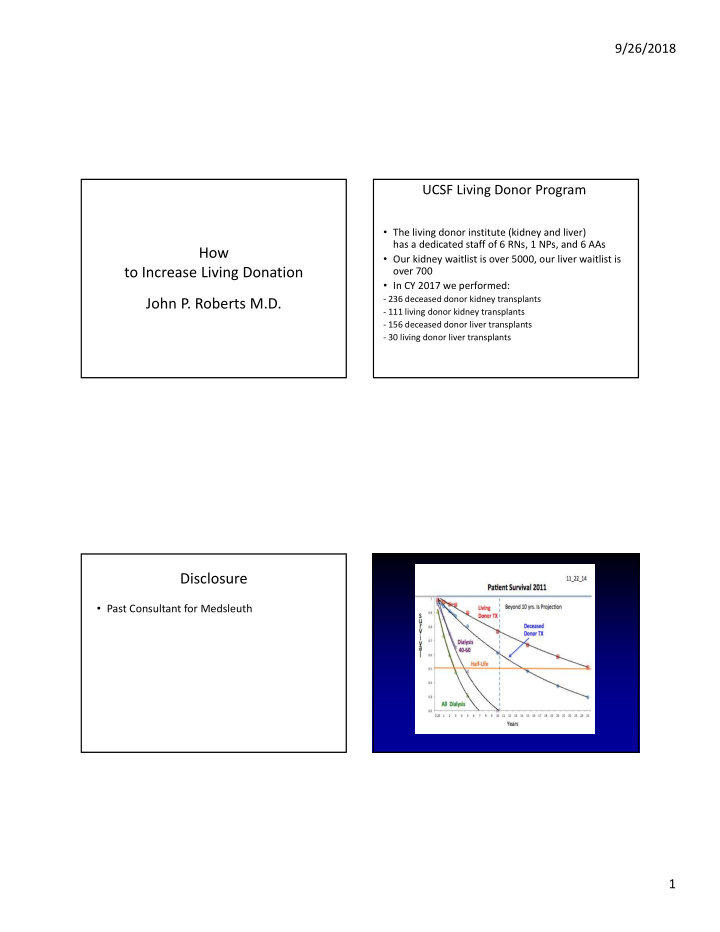



9/26/2018 UCSF Living Donor Program • The living donor institute (kidney and liver) has a dedicated staff of 6 RNs, 1 NPs, and 6 AAs How • Our kidney waitlist is over 5000, our liver waitlist is to Increase Living Donation over 700 • In CY 2017 we performed: ‐ 236 deceased donor kidney transplants John P. Roberts M.D. ‐ 111 living donor kidney transplants ‐ 156 deceased donor liver transplants ‐ 30 living donor liver transplants Disclosure • Past Consultant for Medsleuth 1
9/26/2018 Survival of Leukemia Pancreatic Cancer Survival WorkFlow • Recipient candidate evaluation and listing • Living donor candidate evaluation • Recipient Phase 2 evaluation • Donation/Transplantation • Living Donor follow up • Recipient follow up 2
9/26/2018 Living Donor Evaluation Process Why do we need NEW solutions? Old Way • Manage a high volume of patients (5000+ • Recipients seen at evaluation, given paper HHQ for recipients, 1000+ potential donors). donor or HHQ mailed to donor then mailed back. • HHQ reviewed by RN and many patients immediately • Cut down on use of paper, which is costly to eliminated for BMI, diabetes, stones or hypertension. mail, hard to track, inefficient and time • Onsite Donor workup 1 (labs, urine, BPs, CXR, EKG, HLA consuming for patients, donors and centers. testing) • Reduce barriers for donors. • Results review by RN/MD • Next step was DWU2 (Nephrologist, SW/ILDA, CTA) at • Increase workflow efficiency for transplant UCSF center staff. • Selection • Decrease the time between evaluation and • Surgery transplant • Allow for more transplants. The Patient and the Internet Pain Points • Paper forms • Disease/condition specific searches – Dog ate my homework • Health care products (drugs, devices, health care plans) • Many of the health issues on the forms resulted in donor disqualifications, e.g. Hypertension, diabetes, • Wellness/complementary or alternative medicine could have been eliminated quickly. • Patients had to travel to UCSF for labs and other testing • User created content websites (blogs etc) – Appointments cancelled, no shows – Labs resulted in patients being ruled out which wasted patient and center time. • Quality ranking/patient reviews for doctors/hospitals • Patients needed to return for CT scan. 3
9/26/2018 Completion of Remote Screening Electronic Donor IntAKE • Developed web based intake tool • Up front questions about common rule out causes but nuanced; BMI cutoffs, single drug hypertension, gestational diabetes. • Donors passed up front screen then went to in‐depth questionnaire with questions about medications, fitness, job status, etc. • HHQ created as PDF and then reviewed by nurse or physician to formulate further questions and alternate workups Reasons for Screen Out Smoking, BMI>35, HTN, Drugs Kidney Stones Diabetes • eHHQ 4
9/26/2018 eLab testing • Barrier to donation is initial lab testing if the patient needed to come to UCSF • Local Blood/urine testing at LabCorp. • Paid for by UCSF at LabCorp. • Patients sent map to local lab. • Patients who don’t get labs done are given 2 email reminders and phone call. • Patients who can’t go to local lab for testing aren’t viable donor candidates • Liver donors only have ABO done as eLab as this is the most common reason for rule out in patients who pass HHQ. Advantages of eHHQ eLab Testing • Decrease friction for donors to get • Use of local LabCorp lab at UCSF expense. information about donation and apply online. • Patient can go to lab close to home • Link to website can be ubiquitous. – 66% of those who pass screening get blood work done • Recipients can email potential donors with – Allows for screening out of donors who don’t go explanation of why they need a donor and to lab (34%). include link. – Eliminates center visits for lab failures • Draft email for recipients to send to potential – Result in UCSF EHR electronically donors 5
9/26/2018 Technologies Used in Donor Who Gets Labs Done? Evaluation • Younger less likely than older. ‐ eHHQ – Social Media effect? ‐ eLabCorp/Litholink • Spouse more likely than child ‐Walgreens, • Related twice more likely than unrelated ‐ EHRs and Interfaces • Frequency of exercise related After eLab Living donor Follow‐up • Results reviewed on‐line at UCSF and • Send secure email with personalized web link. decisions made about donor suitability. • Patients complete clinical data at website • Based on ABO testing, donor and recipient • Patient go to LabCorp to get creatinine and ages and HLA testing, decisions made about urinalysis. Provides local LabCorp address. potential exchange candidates. • UCSF pays for LabCorp costs. • Patients with strong possibility of donation • LabCorp data appears in UCSF EMR come to UCSF for social work, physician/NP • Phone call for those who don’t complete and surgeon visits, and radiologic testing. clinical data or lab visit. 6
9/26/2018 Thanks • Claus Niemann • Anna Mello • Carolyn Light • Chris Freise • Living donor liver and kidney teams. 7
Recommend
More recommend